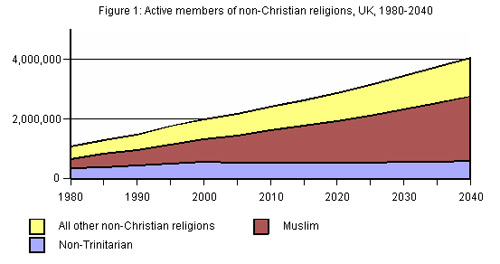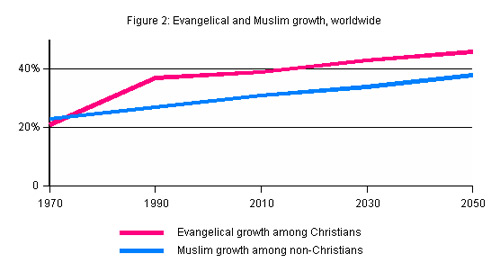The growth of the Muslim community and the decline of church attendance in the United Kingdom seem of perpetual fascination to the media. When the BBC Sunday programme “Heaven and Earth” chose five key facts about religion in Britain to explore, one of them was: “When would Muslim mosque attendance overtake Christian churchgoing?” So what are the actual numbers behind all the interest?
Mosque Attendance
There is no up-to-date reliable information in the UK on how many Muslims actually attend mosque regularly. A comprehensive survey1 was undertaken in 1986 which found that fifty-one percent of Muslims attended one of the main Muslim festivals, such as Idul-Fitr, marking the end of Ramadan, the month of fasting. This is in contrast to the proportion of Christians attending church at Easter or Christmas, variously estimated at between fifteen percent and twenty percent of the population, respectively. This makes up only about twenty-five percent of Christians in the UK. This includes nominal Christians just as the Muslim percentage includes nominal Muslims.
The same survey found that Muslim Friday mosque attendance was sixteen percent which, again, is slightly more than double the percentage of Christians attending church on an average Sunday. A more recent BBC poll suggested the Muslim Friday mosque attendance figure has increased slightly. However, the same survey found that sixty-five percent of attendance was by children. This means that adult attendance is comparable to the adult proportion of Christian Sunday church attendance.
In the absence of other reliable information, the fifty-one percent result (conveniently rounded to fifty percent) is now regularly used to indicate annual attendance or what are sometimes called “active Muslims.” The number of Muslims in the UK is increasing, partly through immigration, partly because Muslims have larger families and partly through conversion (often at marriage). If present trends continue, the number of active Muslims will increase pro rata, rising from half the 2001 Census figure of 1.6 million to half the 2040 estimated number in the UK of 4.3 million (shown in Figure 1 below). The number of active Muslims will outnumber Christian church members by 2049 if nothing changes in the underlying trends.
 |
Mosques
The number of registered mosques in the UK has increased substantially from four in 1960 to 314 in 1985 to 618 in 2002. Mosques, like churches, must be “registered” by the government central Registry Office if lawful marriages are to be solemnised in them. However, also like churches, there are many places of Muslim worship which are not registered. For example, in 2004, the Muslim website had a database of 1,550 mosques. The non-registered mosques, sometimes called “house-mosques,” are in prayer rooms, houses or elsewhere.
This would suggest an average weekly attendance of perhaps 180 people per mosque. Like churches, some are much larger and others much smaller. The London Central Mosque, the largest, has an attendance of five thousand people at festivals.
![]() Again, this average figure is about double the size of an average Christian church, but strict comparisons are not completely valid as there are more than forty-eight thousand churches in the UK, many of which are in rural areas drawing small congregations. The Muslim philosophy of location is much more akin to the Roman Catholic strategy of having relatively few churches or meeting places, and expecting each place to cater to many people. The Catholics have 4,700 churches in the UK with an average mass attendance of 360 people.
Again, this average figure is about double the size of an average Christian church, but strict comparisons are not completely valid as there are more than forty-eight thousand churches in the UK, many of which are in rural areas drawing small congregations. The Muslim philosophy of location is much more akin to the Roman Catholic strategy of having relatively few churches or meeting places, and expecting each place to cater to many people. The Catholics have 4,700 churches in the UK with an average mass attendance of 360 people.
Muslims Worldwide
The number of Muslims, like the number of Christians, is growing worldwide. In 2006, there was an estimated 2.2 billion Christians and 1.3 billion Muslims, both figures including many nominal adherents. These are respectively thirty-three percent and twenty-one percent of the world’s population. More than half the people on planet earth are in one of these two major religions. However, the rate of increase of Muslims at 1.9% per annum is greater than the rate of increase of Christians at 1.3%, which in turn is greater than the rate of increase in the general population at 1.2%.
On the assumption that present trends continue, the number of Muslims is set to become more than the number of Christians, but not until well into the twenty-second century. It should, however, be noted that present trends very rarely continue into the future, and this is as true of the UK as it is of the world figures. Completely unknown factors can radically transform the numbers. Additionally, a number of Muslim lands are liable to environmental catastrophes such as tsunamis, earthquakes and rising sea levels.
Evangelical Growth
Christians worldwide (and in the UK also) divide into two broad groups: evangelicals and non-evangelicals. In both the Developing World and the Developed World, the proportion of evangelicals is increasing, although this is happening for different reasons. In the first, especially Africa, evangelicals are growing because of the number of conversions being seen. In the second, the proportion of evangelicals is growing because the number of non-evangelicals is decreasing faster than the number of evangelicals.2
 |
This increasing evangelical growth, as a percentage of all Christians, is significant. It may be compared with the rate of increase of Muslims (taken as a percentage of non-Christians in the world), as given by David Barrett in the most recent edition of the World Christian Encyclopedia. They are plotted together in Figure 2 above. A small amount of Muslim growth will probably be from the Christian community, but this is discounted as being too few to show.
Why Is All this Important?
Space does not allow us to show the decreasing trends in the non-evangelicals nor the general population who are neither Christians nor Muslim. The only two growing religious movements at the beginning of the twenty-first century are the evangelicals and the Muslims. Their zeal is similar; their devotion is real. Clashes between the two groups have already been seen in places such as Indonesia, India, Nigeria and Pakistan. It is very likely such clashes will continue and even intensify.
How do we prepare Christian people for this challenge to basic religious ideology and how do we best enable people to follow examples such as Martin Luther who said, “Here I stand; I can do no other?” Christians are called by the Apostle Paul to stand for the faith, contesting for the truth seen in a risen and living Jesus Christ, in an uncompromising yet gracious manner both at national and local levels.
Endnotes
1. Holway, Jim. 1986. “Mosque attendance” in UK Christian Handbook, 1987/88 Edition. London: MARC Europe and Evangelical Alliance, 150.
2. For more details, see the article in Religious Trends, no. 5, 2005/2006, edited by Peter Brierley. London: Christian Research, 1, 5.

